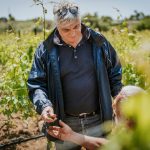What fascinates me most about wine has always been its uniqueness.
I have discovered that the French word ‘Terroir’, which does not have a real translation in Italian, would indicate this originality, we could almost say that it represents the union of wine variables.
Imagine walking through the rows of a vineyard, what surrounds you are these variables:
the grapes, the land you walk on, the sun, the man who is taking care of the plants, the temperature and the tradition of that place.
All these elements, apparently so independent, merge inside the bottle, creating the fascinating liquid that we are used to regarding.
In Italy, this variability is extremely wide and complex, being one of the countries with the greatest biodiversity, geographical diversity and cultural identity.
Just think of the 400 or so indigenous grape varieties, or the various heroic vine-growing methods in the mountains or on the islands, or the numerous lakes and volcanoes, which provide unique soil and climate conditions, or the different wine-growing traditions in each region.
Despite this multiplicity, however, for a long time the wine market has accustomed us to approaching wine in a sterile manner, lacking in emotion and awareness, leading to a flattening of wine identity and, ultimately, to increasingly monotonous products.
This levelling off has had disastrous consequences for the world of wine, such as the abandonment of certain noble trades, such as that of the cooper, or the forgetting of ancient viticultural techniques, or worse, the loss of a multitude of indigenous grape varieties.
However, in recent years, this trend has been reversed, in favour of the recovery of traditions and territorial identity, and this is precisely the right path to follow in order to enhance the uniqueness of our terroirs and the beauty of our wine landscape, favouring practices such as the in-depth study of the soil and the parcelling out of the vineyards, or adopting increasingly less invasive techniques, both in the vineyard and in the winery.
Finally, consumers can also play a fundamental role in ensuring that this idea takes root more and more, by learning to be wary of wine that does not evoke the thought of changeability, that does not change from year to year and that does not express itself with the rhythm of the seasons; and by beginning to be suspicious when it does not tell, in every sip, of the land in which it grew, of the breeze that cooled it, of the sun that protected it and of the hand that knew how to wait for it, with extreme effort and admirable patience.
Ilaria Giardini
Tenuta Liliana Staff





